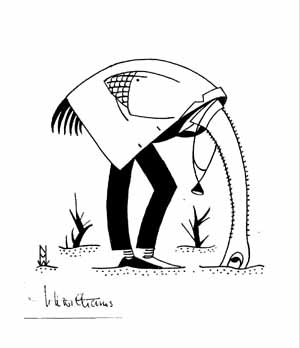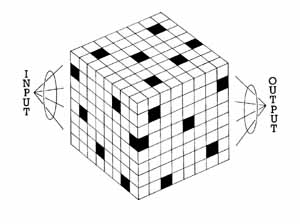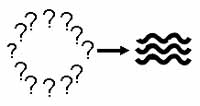Nosokinetics
Issue 3 June 2007
(c)Authors for content; Peter Millard, Roy Johnston for e-version
(comments to rjtechne at iol dot ie)
In this issue:
Revlin Abbi from Elia ElDarzi's group at Westminster describes data mining that reveals four normally distributed groups of stroke patients in the English national data set.Nigel Edwards, plenary talk at the IMA conference, considers present problems and future challenges for modellers of health and social care systems.
Editor on Old physics or new physics: what way should we go? Answers on a post-card please (email will do).
Finally, a special issue call, make a note in your diary for Portrush 18th and 20th March 2008, and look at the logo (see below).
Where to next?
Charting the way forward: only fools succeed.A lead from a Professor at the Cairo Conference led me to read Simon Singh's "The Code Book. The secret history of codes and code-breaking" (Fourth Estate, London, 2000). Three quotes about the history of code-breaking summed up for me the current status of the Nosokinetics endeavour.

Figure 1: The Ostrich Syndrome
Charles Babbage, (1830s) designer of the first mechanical computer:
'Propose to an Englishman any principle, or any instrument, however admirable and you will observe that the whole effort of the English mind is directed to find a difficulty, or an impossibility in it. If you speak to him of a machine for peeling potatoes, he will pronounce it impossible: if you peel a potato with it before his eyes, he will declare it useless, because it will not slice a pineapple.' (opus cit p 64)

Figure 2: Opening the black-box: waves of patients
'Interest in hieroglyphics was reawakened in the seventeenth century, when Pope Sixtus V reorganised the city of Rome according to a new network of avenues, erecting obelisks brought from Egypt at each intersection. Scholars attempted to decipher the meanings of the hieroglyphs, but were hindered by a false assumption: nobody was prepared to accept that the hieroglyphs could possible represent phonetic characters, or phonograms, The idea of phonetic spelling was thought to be too advanced for such an ancient civilisation.' (opus cit p 204)

Figure 3: Only fools succeeds
Martin Hellman, speaking about Ralph Merkle:
'Like us, Ralph was willing to be a fool. And the way to get to the top of the heap in terms of developing original research is to be a fool, because only fools keep trying. You have an idea number 1, you get excited and it flops. Then you have idea number two and it flops. Then you have an idea number 99, you get excited, and it flops. Only a fool would be excited by the 100th idea, but it might take 100 ideas before one really pays off. Unless you are foolish enough to be continually excited, you won't have the motivation, you won't have the energy to carry it through. God rewards fools. (opus cit p 256)
Footnote: In 1974 Mrs Williams, a friend of my mother drew, the Ostrich Syndrome pictures for a tape slide presentation we made at St. George's Hospital for the Health Advisory Service, to illustrate the benefits of teamwork and specially designed environments in the medical care of old people. The box was drawn in 1988 by Anthony Burgess my wife's sister's son. So do the obsessed involve others in their plans.
Call for Papers:
Interfaces Special Issue, Deadline: 15th September 2007:Applications of Management Science and Operations Research Models and Methods to Problems in Health Care; Editors: Michael Carter, Bruce Golden & Edward Wasil
Success stories in applying MS/OR models and methods to actual problems in health care. Success stories could be tool oriented, such as describing a simulation model for patient flow, or focused on strategic, policy-level applications, such as deciding where a government should allocate its health-care funds and how it should distribute its resources. Benefits obtained and lessons learnt need to be specified. A verification letter from relevant organization is essential.
Interfaces Instructions to Authors at http://interfaces.pubs.informs.org/guidelines.htm
Papers must be submitted online using Manuscript Central at http://mc.manuscriptcentral.com/inte
All papers will be refereed.
Further information: carter@mie.utoronto.ca
Looking for data?
The Trends in Health and Aging site http://www.cdc.gov/nchs/agingact.htm is a comprehensive source of information about the health status, health behaviors, health insurance coverage, health care expenditures, and the use of health services by the aging population in the U.S. It is maintained by NCHS and is supported by the National Institute of Aging of the National Institutes of Health.
Solve the conundrum:
How many overnight beds do Australian Hospitals need?The Australian Institute of Health and Welfare (AIHW) report, Australian hospital statistics 2005-06, is now available at http://www.aihw.gov.au/publications/index.cfm/title/10455
Bed numbers decreased. During 2005-06, Australia had 1,291 public and private hospitals, with almost 82,000 available hospital beds. Public hospital bed numbers decreased by 0.9%, to about 54,600, and private hospital beds increased by 3.0%, to about 27,200.
Hospital admissions to both sectors increased by 4.2% from 7 million in 2004-05 to 7.3 million in 2005-06. public hospitals admissions increased by 4.5% and private admissions by 3.3%.
Days Australians spent in hospital was 24.3 million, '...2% higher than in the previous financial year...' said Mr George Bodilsen of the Institute's Hospitals Unit.
Same-day hospital admissions increased between 1996-97 and 2005-06 rose from 45% of admissions to 55% i.e. a 1% increase each year. Now, almost half of admissions in public hospitals and 64% in private hospitals are day patients.
Average stay for all admissions fell by 21% between 1996-97 and 2005-06, from 4.2 days to 3.3 days i.e .by 2% a year, however.Inpatient stay remained fairly constant: In 2005-06, 6.3 days in public acute hospitals and 5.4 days in private hospitals.
PhDs on the web
Much of the research associated with the development of new methods of measuring and modelling health and social care systems is in doctoral theses or in Operational, Mathematical or Computational journal and Conference proceedings. To facilitate understanding of the doctoral research that underpins the Nosokinetics endeavour began, we seek to create a doctoral archive on the web. With this in mind I have been working to put my 1992 PhD thesis onto the web.The research was a bed census and clinical practice study in thirteen departments of geriatric medicine to validate the Harrison two compartment model. Thousands of facts were collected, however only three correlated with the speed of treatment of short stay patients: consultants opinion re ease of discharge to nursing homes, number of patients coded for discharge to nursing homes and the nurses opinion regarding rehabilitation. With several caveats admission policies, staff levels and facilities were not the major cause of differences in length of stay.
Second International Health and Social Care
Modelling Conference (HSCM 2008)
Portrush, Northern Ireland 18 - 20 March, 2008The first International Health and Social Care Modelling Conference of the Nosokinetics Group, at the University of Adelaide in April, 2006 provided a unique opportunity for researchers and practitioners to meet, exchange ideas, examine the current modelling trends and issues, and develop new solutions and research directions to ultimately, improve patient and client care.
The Second International Health and Social Care Modelling Conference (HSCM2008) organised by the University of Ulster will take place from 18th-20th April 2008 in Portrush, Northern Ireland. Portrush is a small seaside town on the North Coast of Ireland, with beautiful beaches, convivial restaurants and friendly pubs. It is close to the Bushmills Distillery and Giant's Causeway and part of the Causeway Coast Area of Outstanding Natural Beauty.
For further details contact Sally McClean (si.mcclean@ulster.ac.uk
'..Peter, I suggest a Symbol for Nosokinetics which is a circle of question marks, then a horizontal arrow to the right of that circle followed by a few wavy lines, three or four above each other, like the sea. It represents all of your enquiries that fell into the smooth flow of implementation...'
Herewith my attempt to draw it. Other attempts or suggestions gratefully received:
Alan Morris's Draft Logo
Copyright (c)Roy Johnston, Ray Millard, 2005, for e-version; content is author's copyright,
Logo
Alan Morris, a medical colleague from my student days, on the same dissecting table, wrote: 
Some navigational notes:
A highlighted number may bring up a footnote or a reference. A highlighted word hotlinks to another document (chapter, appendix, table of contents, whatever). In general, if you click on the 'Back' button it will bring to to the point of departure in the document from which you came.